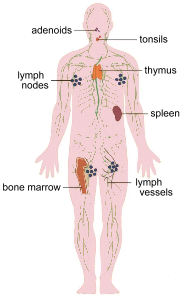
 Your immune system is a large network of organs, white blood cells, proteins and chemicals. These parts all work together to protect you from germs and other invaders. Your immune system also helps your body heal from infections and injuries.
Your immune system is a large network of organs, white blood cells, proteins and chemicals. These parts all work together to protect you from germs and other invaders. Your immune system also helps your body heal from infections and injuries.
Invaders your immune system protects you against include:
Bacteria
Viruses
Fungi that can cause infections
Parasites
Cancer cells
When your immune system is working properly, it can tell the difference between cells that are yours and those that donít belong in your body.
It also learns about germs after youíve had contact with them, and develops antibodies against them.
The main components of your immune system are:
- White blood cells: These immune system cells in the blood stream attack and eliminate harmful germs. There are many types of white blood cells, and each has a specific role in your bodyís defense system.
- Antibodies: These proteins protect you from invading germs by binding to them and then destroying them.
- Cytokines: These are also proteins; they serve as chemical messengers that tell your immune cells where to go and what to do. Different types of cytokines do different tasks, like controlling inflammation. Inflammation happens when your immune cells are warding off invaders or healing damage to your tissues.
- Lymph nodes: These small organs filter waste products from the fluid (lymph) that drains from your tissues and cells. There are hundreds of lymph nodes throughout your body.
- Spleen : The spleen stores white blood cells. It also filters your blood, recycling old and damaged cells to make new ones.
- Tonsils and adenoids: Located in your throat and nasal passage, tonsils and adenoids trap bacteria and viruses as soon as they enter your body.
- Thymus: The small thymus helps T-cells (a specific type of white blood cell) mature before they travel elsewhere in your body to protect you.
- Bone marrow: This soft, fatty tissue inside your bones is a factory for blood cells. It makes the blood cells your body needs to survive, including white blood cells that support your immune system.
- Skin: Your skin is the largest organ in the body, and the body's first line of defense against germs. Breaches in this defense - cuts or wounds - are quickly healed by the blood, which clots and forms a scab. Blood vessels open wider to allow more oxygen into the healing tissue. Red blood cells help build new tissue.
- Mucosa: This membrane lines cavities and organs throughout your body. It secretes mucus that captures germs, for your body to then clear out.
Innate immunity is protection that youíre born with. It responds to invaders right away by attacking any organism that shouldnít be in your body. White blood cells don't need training to tell which cells it encounters are invaders. However, they donít learn to recognize certain invaders, and have no memory of attacking invaders, so they can't offer future protection against specific germs or the infections they cause.
Acquired immunity is protection your body acquires over time from exposure to germs. Certain white blood cells called T-cells or lymphocytes remember specific invaders and can tell when they donít belong in your body. If those invaders try to get in again, the lymphocytes can quickly eliminate the threat. Some vaccines support your acquired immunity by training its cells to identify and destroy small samples of invaders before they can make you sick.
Resources
HTML & design by Bill Willis 2024
|

 Your immune system is a large network of organs, white blood cells, proteins and chemicals. These parts all work together to protect you from germs and other invaders. Your immune system also helps your body heal from infections and injuries.
Your immune system is a large network of organs, white blood cells, proteins and chemicals. These parts all work together to protect you from germs and other invaders. Your immune system also helps your body heal from infections and injuries.